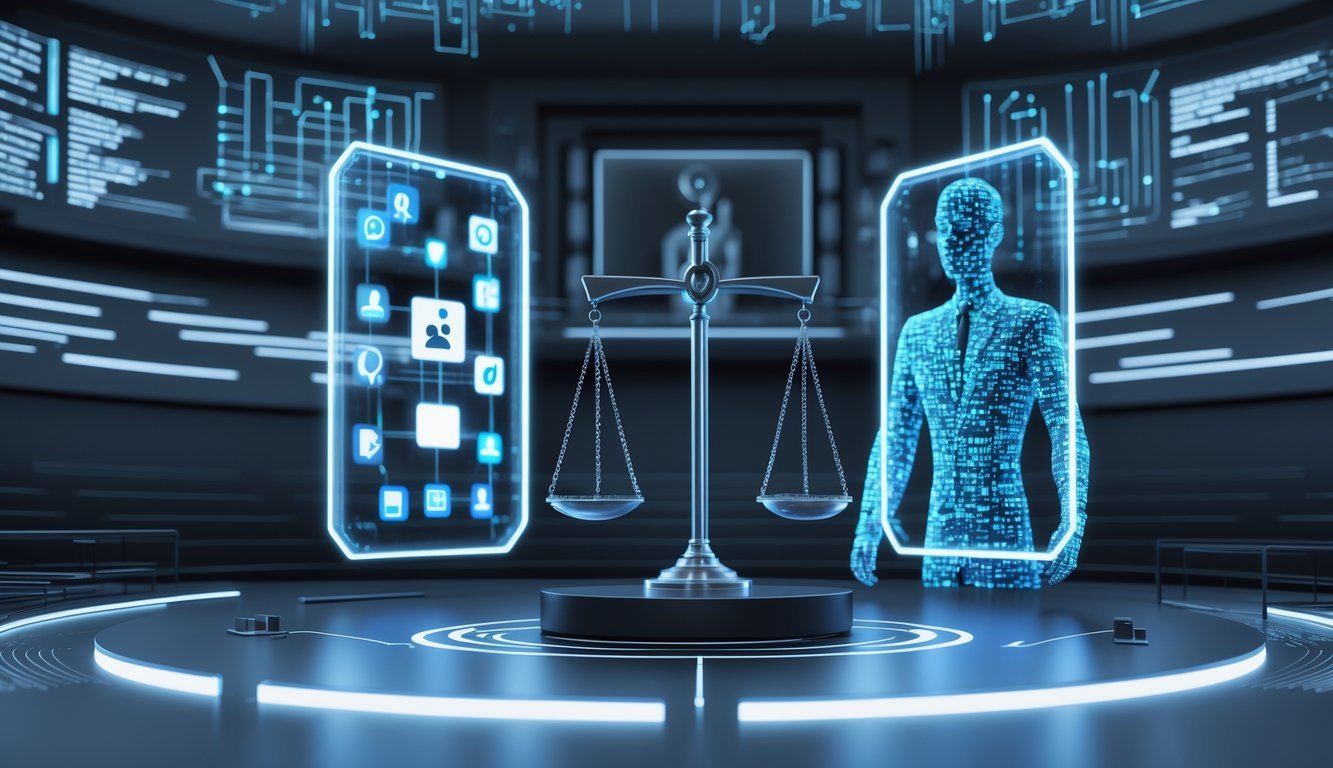Social media posts and online comments can get out of hand fast. What starts as a casual opinion sometimes spirals into a real legal mess.
Cyber defamation happens when someone puts out false statements online that hurt another person’s reputation. Victims can end up dealing with the same legal fallout as in old-school defamation cases. Courts are getting pretty sharp about social media issues, and they don’t hesitate to hold people responsible for posting or sharing harmful stuff.

The internet has totally changed how defamation cases play out. Screenshots stick around forever, and viral posts can reach thousands in just a few hours.
If you understand the main legal rules about online speech, you’re less likely to accidentally cross the line from protected opinion to defamation. Platforms like Facebook, Twitter, and Instagram have made things trickier for both people seeking justice and those suddenly facing lawsuits.
When it comes to legal remedies, they range from cease-and-desist letters to big money damages. Some payouts have gone well over a hundred thousand dollars.
Courts keep updating their approach as they try to fit old defamation laws into our digital world. If you’re accused or thinking about suing, it’s important to know your options and what might happen next.
Key Takeaways
- Cyber defamation uses the same legal rules as regular defamation, but it happens online
- Remedies might include money damages, court orders to remove posts, or other penalties that can get expensive
- Knowing defenses like truth, fair comment, and privilege helps people stay on the right side of the law when posting online
Core Principles Of Cyber Defamation Law

Cyber defamation law basically runs on four main ideas that judges use to look at online statements. These principles help decide when false statements stop being free speech and start being a legal problem.
They also set the rules for proving harm and damages.
Defining Online Defamation and False Statements
Online defamation happens when someone puts out a false statement about another person on a digital platform. The statement needs to sound like a fact, not just an opinion.
Key Requirements for Defamatory Statements:
- The statement is false or misleading
- Someone published it so at least one other person saw it
- The victim gets identified, even if it’s not by name
- The statement actually hurts their reputation
Courts treat social media, videos, and comments just like newspapers or magazines. A recent British Columbia case about a YouTuber really drives this home.
That YouTuber accused a beauty company of things like money laundering and fraud. The court said those statements were defamatory since they sounded like facts, not just opinions.
Platform Types Covered:
- Social media sites
- Video sharing platforms
- Blogs and websites
- Email and messaging apps
Online defamation can be more damaging than old-school defamation because posts stick around and spread fast.
Key Legal Standards and Burden of Proof
The person suing (the plaintiff) has to prove certain things to win a defamation case. The proof needed changes based on whether the plaintiff is a public or private figure.
Standard Elements to Prove:
- Publication – Someone else saw or read the statement
- Identification – The victim can be recognized
- Falsity – The info isn’t true
- Harm – The victim’s reputation took a hit
Regular people usually have an easier time than public figures. Public figures also have to show the defendant acted with “actual malice”—basically, they knew it was false or just didn’t care.
Evidence Courts Like:
- Screenshots of posts or comments
- Website archives and timestamps
- Witnesses who saw the online content
- Experts who explain how far the post spread
Since online content sticks around, it’s easier to save evidence. Courts can look at the exact words and see how far they traveled.
Digital platforms keep records that show when and how widely a statement spread.
Reputational Harm and Strict Liability
Judges understand that online statements can really wreck someone’s reputation because they travel so far and fast. The damage often goes way beyond the first group who saw the post.
Plaintiffs need to show real harm to their reputation, business, or personal life. If you can prove you lost money, your case gets stronger.
Recognized Harm:
- Lost business deals or jobs
- Ruined professional relationships
- Emotional distress or harassment
- Lower standing in the community
The British Columbia YouTuber case led to $350,000 in damages, including extra money for malicious behavior. The court said the false statements had a huge impact.
Types of Damages:
- General damages – For the hit to your reputation
- Aggravated damages – Extra money for malicious actions
- Punitive damages – Punishment to discourage future bad behavior
Some places use strict liability, so you might get held responsible just for publishing something false and defamatory—even if you didn’t mean to cause harm.
Balancing Free Speech and Protection from Harm
Judges have to juggle free speech rights with the need to protect people from defamation. It’s a tough balance.
Freedom of expression isn’t unlimited, even in countries that really value it. If you make a false statement that hurts someone, that’s usually not protected.
Protected Speech:
- Opinions and commentary
- Personal beliefs
- Satire
- Matters of public concern
Not Protected:
- False facts
- Defamatory claims
- Malicious lies
- Privacy invasions
Judges look at things like why the person posted, if the topic matters to the public, and who the victim is.
Platform immunity laws make things more complicated. Some countries give safe harbor protections to platforms that just host user content.
Content creators and regular users can still get sued for what they post. Platforms usually only get in trouble if they refuse to take down clearly defamatory stuff after being told about it.
Legal Remedies And Enforcement For Cyber Defamation

If you’re a victim of cyber defamation, you usually have three main options: emergency restraining orders, civil lawsuits for money, and legal defenses to fight back against false claims.
Restraining Orders and Removal of Harmful Content
Judges can hand out temporary restraining orders to stop defamatory content from spreading. These orders force the person who posted to take down the harmful stuff right away.
Victims need to show they’re facing immediate harm that money can’t fix. Judges look at things like ongoing harassment or serious reputation damage.
Emergency orders sometimes come through in just a day. Victims might have to post a bond to cover any damages if the order turns out to be wrong.
Social media companies usually take down posts quickly when a court orders it. Their legal teams handle these requests all the time.
Some states also let courts issue preliminary injunctions that last longer than temporary orders. These need more evidence but offer stronger protection while the lawsuit plays out.
Civil Lawsuits and Financial Damages
Victims can sue for compensatory damages to get back lost income, medical bills, or therapy costs caused by emotional distress.
Punitive damages go to punish someone who acted with real malice. Judges award these when the defamation was especially nasty or intentional.
The Mary Kate Cornett case with ESPN’s Pat McAfee shows how viral lies can lead to brutal harassment. Her lawyer said, “you can’t lie about someone with impunity.”
Private individuals don’t have to meet as high a standard as public figures. They just need to show the defendant was careless, not that they meant to harm.
Emotional distress claims require proof that the conduct was extreme and caused serious psychological harm.
Defenses Available in Cyber Defamation Cases
Truth is the best defense. If you can prove your statement was true, you’re off the hook.
Opinion protection covers things that can’t be proven true or false. Saying “I think he’s a bad manager” is usually safe.
Privilege protects some types of speech, like statements made in court or during government debates.
Section 230 shields internet platforms from being sued for what users post. But it doesn’t protect the users themselves.
Fair comment lets people criticize public figures or issues of public interest, as long as the statement relates to their public role.
Statute of limitations sets a deadline for filing a lawsuit, usually one to three years depending on the state. If you wait too long, you might lose your chance.
Frequently Asked Questions

Online defamation cases require proof of things like false statements and actual harm to reputation. Social media makes these cases trickier for everyone involved.
What constitutes defamation of character on social media platforms?
Defamation on social media happens when someone puts out false statements that hurt another person’s reputation. The statements need to sound like facts, not just opinions.
Posts, comments, videos, or images that falsely accuse someone of a crime are defamatory. Same goes for false claims about someone’s job performance or personal life.
Defamation lawsuits involving influencers show that even jokes or satire can lead to legal trouble. The context and how the audience sees it matter more than the format.
If you share or repost something defamatory, you can get held responsible too. Every share is a new publication.
What are the legal repercussions of online defamation?
People found guilty of online defamation might have to pay money for the harm they caused. Judges can order them to pay for lost income, emotional pain, or damage to someone’s career.
Courts can make defendants take down defamatory posts. Sometimes they even order public retractions or corrections.
If someone acted with real malice, judges might award punitive damages. That’s on top of regular compensation and meant to punish the bad behavior.
Sometimes, criminal charges apply if the defamation turns into harassment or stalking. Tech-based violence against women often includes defamatory posts meant to scare or control.
What are the key elements required to prove a case of defamation?
The plaintiff needs to show the defendant published a false statement of fact about them. Opinions or wild exaggerations usually don’t count.
The statement must have reached at least one other person. Social media posts usually meet this bar right away.
Plaintiffs must prove the statement damaged their reputation. This might mean lost business, broken relationships, or serious emotional distress.
If the plaintiff is a public figure, they also need to show the defendant acted with actual malice—basically, they knew it was false or didn’t care.
How can individuals protect themselves from defamation in a digital context?
Always double-check facts before posting about someone else online. Looking at multiple sources and steering clear of rumors goes a long way.
If you make it clear you’re sharing an opinion—using phrases like “I believe” or “in my opinion”—you’re less likely to get sued.
Try to avoid personal attacks and stick to public issues. First Amendment protections are stronger for matters of public concern.
Keep an eye on your online mentions. If you spot something false early, you can respond quickly and maybe avoid bigger problems.
What precedents have been set by recent online defamation cases?
Courts now recognize that a social media post can wreck someone’s reputation just as much as a newspaper article. Because online content is permanent and easy to search, damages can be bigger.
Recent cases show that even satire or jokes aren’t always safe—context and how the audience understands the statement matter most.
Shield laws for journalists sometimes cover online writers and bloggers too. Federal courts keep looking at whether these laws apply to digital news sources.
When judges decide how much to award, they consider how far and fast a post spread. The more viral the post, the higher the possible damages.
What remedies are available to someone who has been defamed online?
If someone’s been defamed online, they can ask for monetary damages. This money covers harm to their reputation and any financial losses.
Courts sometimes give both actual damages and, in really serious cases, punitive damages.
Judges can also order people to take down defamatory posts. They might require the person to stop making false statements in the future.
This helps deal with the harm that sticks around when bad content stays online.
Courts can tell people to publish retractions or corrections, too. These fixes need to show up where the original post did, so people actually see them.
Some websites let you report defamatory stuff through their own systems. That can get things taken down faster than going to court, but these platform tools don’t have legal teeth.

